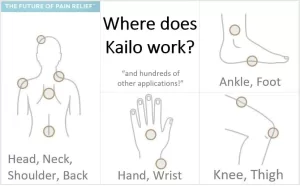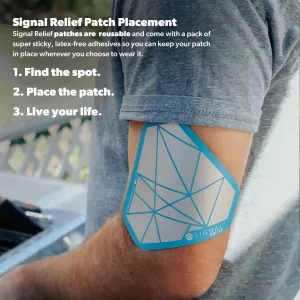
Pain Patches are Perfect for All Day Relief While Traveling
We’re always trying to find ways to manage our chronic pain while traveling, but it’s hard to keep up with all the new pain products popping out. Pain Patch products are a great option for people who are on the go and want to get some relief right away. We’ve seen a lot of different types of pain relief, like topical ointment, electrical stimulation, and even nanoparticles. But what’s the science behind them? We’ll look at how they work, how effective they are, and why they’re so useful when you’re on the go.

Understanding Pain Patches
In our quest to alleviate the discomfort of chronic pain, back pain, and muscle aches, a myriad of products have been developed and made available in patch- form.
These adhesive devices applied directly to the skin, aim to deliver targeted relief right where it’s needed. Many function by gradually releasing pain-relieving analgesics through the skin and into the underlying tissues. Others use medicine of a more ephemeral nature.
Whether you’re dealing with the persistent nagging of chronic pain, the sharp jolt of an aching back, or the dull throb of overworked muscles, understanding the science and effectiveness of these patches could be a go-to solution while traveling.
Pain Patches and Travel
The best part about pain patches is that they’re easy to carry around. They’re compact and lightweight, so you can easily slip them into your bag or pocket. Unlike oral medications, which may require water to be ingested, pain patches allow you to apply them anytime, anywhere. They also provide long-term relief, so you may not need to take multiple pain patches throughout the day. That’s especially useful on long trips. Plus, since they’re directly applied to the area of pain, you’ll get targeted relief, allowing you to continue your adventures with minimal interruption. This is particularly good for muscle aches, spasms and arthritis.
Read Related Article: Society Hotel Sanctuary
ADVERTISEMENT
TENS Units
Transcutaneous Electrical Nerve Stimulation (TENS) is a method of pain relief that works by delivering small electrical impulses to the body’s nerve or muscle fibers through the skin. These electrical charges are generated by a device and transmitted via electrodes attached to the skin.
On a basic science level, TENS operates on two primary theories: gate control theory and endorphin release theory. According to the gate control theory, TENS impulses interfere with pain signals traveling to the brain, essentially ‘closing the gate’ to these signals and preventing the sensation of pain from being perceived. On the other hand, the endorphin release theory suggests that TENS stimulates the production of endorphins, the body’s natural painkillers, which reduce the perception of pain.
Clinical research supports the efficacy of TENS for various types of pain. A multitude of studies have demonstrated its benefits in conditions like osteoarthritis, fibromyalgia, and postoperative pain. TENS is generally considered safe, with few side effects, making it a valuable and often-used tool in managing different pain conditions. However, the effectiveness of TENS can vary widely among individuals, and it is often used as part of a broader pain management strategy.
Effectiveness of TENS in Treating Hyperalgesia and Severe Pain
TENS (Transcutaneous Electrical Nerve Stimulation) has been shown to be effective in treating hyperalgesias and moderate to severe pain, making it a valuable option for those traveling with chronic pain. Multiple studies have demonstrated TENS’s effectiveness in reducing hyperalgesias, primarily attributed to its ability to modulate pain signal transmission. Additionally, TENS can stimulate the release of endorphins, offering natural pain relief. When dealing with severe pain, outcomes may vary, but TENS can still provide a useful tool for managing discomfort while traveling.
Some research suggests that TENS may be effective in treating severe pain, especially when used in combination with other pain management therapies and medications. However, more research is needed to understand exactly how TENS works and what are the optimal parameters for severe pain management.
It is important to note that TENS is not intended to be used on its own to treat severe pain or hyperalgesias, but rather as part of an overall pain management plan.
Capsaicin
Capsaicin, a compound found in chili peppers, has potent analgesic properties that make it effective in managing neuropathic pain as well as acute and chronic muscle pain. The substance works by binding to a receptor in the body called TRPV1, which is involved in transmitting pain signals to the brain. When capsaicin binds to this receptor, it produces a sensation of heat or burning. This initially stimulates pain, but it subsequently leads to a desensitization of the pain-sensing nerves, resulting in a decreased perception of pain.
In the case of neuropathic pain, capsaicin has shown the ability to provide relief by disrupting the transmission of pain signals to the brain. It can help reduce the hyper-sensitivity often experienced in neuropathic pain conditions, effectively calming the nerves and reducing the overall pain level.
Furthermore, capsaicin’s analgesic effects also extend to acute and chronic muscle pain. It aids in relieving muscle pain by reducing the production of a neuropeptide associated with inflammation and pain, called Substance P. Reduced levels of this substance result in less pain sensation and inflammation, providing relief to the affected muscles.
Notably, capsaicin is often used in topical creams and patches where its analgesic properties can be localized to the area of pain, offering targeted and effective pain relief. However, it’s important to remember that while capsaicin can help manage pain, it’s generally more effective when used as part of a comprehensive pain management approach, often in conjunction with other therapies and medications.
Nanotechnology
Nanotechnology is a rapidly emerging field that holds substantial promise in the arena of pain relief. It involves the manipulation of materials at the molecular level to create new structures with unique properties. Nanotechnology-based drug delivery systems, for instance, provide numerous advantages for pain management, including enhanced absorption, bioavailability, and targeted delivery.
A prevalent application of nanotechnology in pain relief is in the fabrication of nanostructured pain patches, like the Kailo Pain Patch mentioned earlier. These patches employ nanocapacitors that enhance the body’s natural bioelectric signals, enabling more effective communication between the nervous system and the brain, thus facilitating better pain management.
Another promising application of nanotechnology is in the form of nanofibres and nanoparticles loaded with analgesics or anti-inflammatory agents. These nanoscale carriers can deliver drugs directly to the site of pain, thereby maximizing therapeutic effects and minimizing systemic side effects.
In summary, nanotechnology offers innovative and highly effective pain management solutions by exploiting the unique properties of materials at the nanoscale. It not only enhances the effectiveness of traditional pain relief methods but also introduces entirely new mechanisms of analgesia, opening up new horizons in the field of pain management.
Kailo Pain Patch
The Kailo Pain Patch operates on an interesting and unique mechanism of action. It is built with nanocapacitors that interact with the body’s electrical system. Essentially, this patch functions as a bio-antenna, designed to boost the natural signals of the body, helping it communicate more effectively and thus alleviate pain. When you experience pain, it’s typically a result of the electrical signals in your body not functioning properly. The Kailo Pain Patch helps to restore this proper communication, reducing the sensation of pain. The patch doesn’t use any drugs or chemicals, nor does it require any special power source. It’s a non-invasive and drug-free solution to pain, highlighting the marvels of bio-technology in contemporary pain management strategies.
The Kailo Pain Patch interacts with the body’s electrical signals through its embedded nanocapacitors. Nanocapacitors are components that can store and discharge electrical energy, functioning as a conduit for the body’s natural bioelectricity. When the Kailo patch is adhered to the skin, it creates an electrical connection with the body’s nervous system. This connection allows the patch to effectively ‘read’ the electrical signals being sent around the body, particularly those associated with pain.
The nanocapacitors in the Kailo patch then work to enhance the body’s natural signals, essentially facilitating better communication between the nervous system and the brain. It’s akin to tuning a radio to a clear signal. This improved communication helps the body send more accurate information about the pain, leading to more effective pain management. It’s important to note that the Kailo Pain Patch doesn’t generate any electrical charges on its own; it merely works with the body’s existing bioelectrical system to help alleviate pain.
Signal Relief Nano Patches
Signal Relief is another top brand in the pain patch industry that harnesses the power of nanotechnology to alleviate pain. Similar to the Kailo Pain Patch, Signal Relief operates on the principle of bioelectricity, interacting with the body’s natural electrical system to modulate pain signals.
The Signal Relief patch contains a proprietary arrangement of micro-nano capacitors shaped into a tri-layered configuration, which acts in harmony with the body’s electric field to provide relief. As pain is fundamentally an electrical signal sent by the body to the brain, the Signal Relief patch aims to disrupt these signals, effectively ‘turning off’ the pain.
Upon application, the patch begins to interact with the electrical field of the body. It reads and responds to the body’s distress signals, working to correct the miscommunications or disturbances that lead to the sensation of pain. The patch doesn’t introduce any foreign electricity into the body, nor does it utilize any pharmaceutical agents. It is a non-invasive, drug-free approach to pain management, offering a potentially safer and more sustainable option for chronic pain sufferers.
It is crucial to note that efficacy can vary across individuals. Therefore, while brands like Signal Relief and Kailo represent promising advancements in pain management technology, they should ideally be employed as components within a broader, personalized pain management strategy.
Lidocaine and Menthol
Lidocaine Patches
Lidocaine patches have received approval from the U.S. Food and Drug Administration (FDA) specifically for the treatment of postherpetic neuralgia (PHN), a debilitating pain condition that can develop after shingles. This endorsement stems from clinical research demonstrating lidocaine’s capacity to alleviate the persistent and often severe pain associated with PHN. By directly applying the lidocaine patch to the area of pain, patients can experience targeted relief without a significant risk of systemic side effects. However, as with any medication, usage should be under the guidance of a healthcare professional to ensure proper administration and to monitor potential adverse reactions. It’s also worth noting that while the FDA has specifically approved lidocaine patches for PHN, they are often used off-label for other types of neuropathic pain.
Mentholated Pain Patches
The benefits of mentholated pain patches are backed by substantial evidence, highlighting their efficacy in managing various pain conditions. Menthol, a compound derived from peppermint oil, imparts a cooling sensation when applied to the skin, which can help mask the feelings of pain in the underlying tissues. This effect is due to menthol’s ability to stimulate specific receptors (known as TRPM8) in the skin, which are responsible for sensations of cold. When these receptors are activated, they can inhibit the transmission of pain signals to the brain, thereby reducing the perception of pain. Additionally, menthol is also known to have anti-inflammatory properties, which further aids in alleviating pain. Several studies have validated the effectiveness of mentholated patches in providing relief for conditions such as muscle strains, joint pain, and neuropathic pain. However, as with other topical analgesics, it is most beneficial when used as part of a comprehensive pain management plan.
Conclusion: The Importance of Practical Solutions for Travelers with Chronic Pain
Providing practical solutions for adult travelers with chronic pain is crucial. The freedom to explore new places and cultures should not be limited by chronic pain. However, the reality for many is that chronic pain can significantly hamper their travel plans. Traditional methods of pain relief, like oral medication, can be inconvenient and impractical, especially while on the move.
Pain patches, on the other hand, offer an effective, accessible, and travel-friendly solution. They can be easily packed and applied, providing sustained and targeted relief. Furthermore, their use doesn’t interrupt travel itineraries, ensuring that the joy and excitement of exploration are not diminished by the constant management of pain. Indeed, practical solutions such as pain patches are an essential component of empowering adults with chronic pain to continue living vibrant and adventurous lives.











